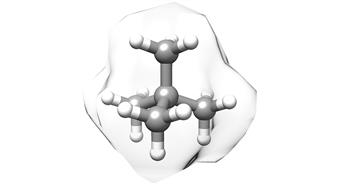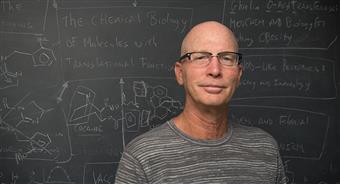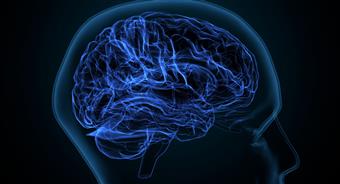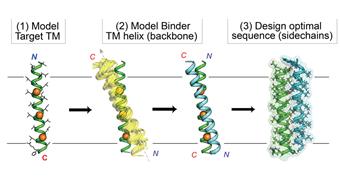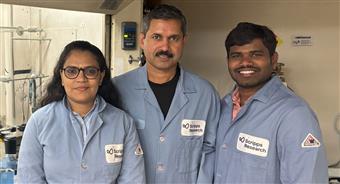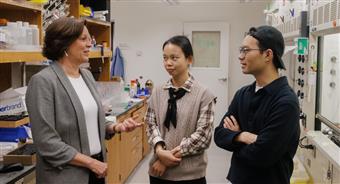
Immune activation in the liver illuminated with new glycan-tagging strategy A new chemistry technique expands known targets of signaling protein galectin-3, with implications for liver disease and the immune system.
October 19, 2020
JUPITER, FL Human cells are encased by a membrane coated with diverse sugar molecules known as glycans. These glycans play many roles in health and disease, making them important to understand. Due to their unique properties, however, scientists have had limited tools to study them and their interactions in the body.
New research from the lab of biochemist Mia Huang, PhD, an assistant professor at Scripps Research in Jupiter, Florida, presents a strategy for capturing elusive interactions among glycans and their protein activators in live human cells. Huang and her colleagues applied the technique to improve understanding of liver disease and immune activation.
Writing in the journal the Proceedings of the National Academies of Sciences on Friday, Huang and colleagues focus on a glycan-binding protein called galectin-3. Collaborating with the lab of Scripps Research chemist Chris Parker, PhD, the team was able to catalog galectin-3's array of receptors by combining two strategies: proximity labelling and quantitative proteomics.
In the process, they discovered hundreds of galectin-3 interactors in live liver stellate cells and immune cells.
These interactions escape traditional query because of their weak affinity and dynamic binding events, Huang says. Our findings will empower our ability to approach, and hopefully treat, diseases based on glycosylation-mediated events, especially liver fibrosis and autoimmune disorders.
Finding the hook
Cells communicate with each other through the release of molecular signals. These signals, such as galectin-3, can activate the inflammatory response following viral infection, or generate a buildup of scar tissue following injury, for example.
At the biochemical level, for this to happen, a glycan-binding protein must attach to its membrane receptor like a fisherman's line hook wading through thick kelp to find its catch. Characterizing which hooks fit which glycoproteins is a necessary step to addressing the root causes of many illnesses, Huang says.
A graduate student in Huang's lab, Eugene Joeh, devised a chemical fishing expedition to search for galectin-3. Joeh, a student in Scripps Research's Skaggs Graduate School of Chemical and Biological Sciences, suggested tethering an enzyme called APEX2, chosen for its relatively small size and ability to stay active both inside and outside the cell, to the galectin-3 molecules. He then allowed the paired molecules to freely diffuse onto cells. Next, he added the chemicals biotin phenol and hydrogen peroxide to create highly reactive tags that label the binding complexes so that they could be more easily identified and characterized. He was helped by a participant in the institute's high school internship program, Kenan Fellow Jonathan Hung, a student at Suncoast High School at the time of his internship, now a freshman at Johns Hopkins University.
Liver fibrosis and beyond
The liver plays many roles. It processes nutrients and medicines absorbed through digestion. It clears toxins, breaks down alcohol, and stores or releases fats and sugars during times of plenty or scarcity. It makes bile to help digest fats. Over time, injury to the liver from conditions such as alcoholism, autoimmune disease, drug abuse, or viral hepatitis, can lead to a condition called liver fibrosis. This can cause chronic high blood pressure, cirrhosis or even liver failure.
The events that lead to this unhealthy cascade involve an interaction between liver-based immune white blood cells called macrophages and fat-storing liver cells called stellate cells. The cascade begins when liver macrophages activate liver stellate cells through the release of galectin-3. The docking of galectin-3 to its sugary glycoprotein receptors triggers the stellate cell to ooze collagen and make other changes.
This signal, galectin-3, isn't only a force to consider in liver fibrosis. It also plays an important role in other cells especially those in the immune system that help defend against infections, cancer and poisons, Huang says.
It is noteworthy that several of these proteins are important in both the innate and adaptive immune responses, Huang says.
The discovery of so many galectin-3 receptors raises many new questions, she adds. The work continues.
This has given us a priority list of proteins that will be the subject of further work on the regulation of immunity and the activation of liver stellate cells, she says.
The study, Mapping glycan-mediated galectin-3 interactions by live cell proximity labeling, appears Oct. 16, 2020 in the Proceedings of the National Academy of Sciences. In addition to lead author Huang, first author Joeh, and Kenan Fellow Hung, authors include Parker, Timothy O'Leary, Weichao Li and Richard Hawkins, all of Scripps Research.
The work was supported by the National Institutes of Health Pathway to Independence
Award (R00HD0292-03), the Joe W. and Dorothy Dorsett Brown Foundation, and the Henry and Jennifer Luttrell Foundation's Skaggs Graduate Fellowship program.
Chemistry Huang, Mia Parker, Chris
More from Scripps
12/04/2024
Scripps Research chemists devise easier new method for making a common type of building block for drugs Scientists transform simple linear amines into saturated...
06/04/2024
A simple, inexpensive way to make carbon atoms bind together A Scripps Research team uncovers a cost-effective method for producing quaternary carbon molecules,...
04/04/2024
Developing a vaccine for the zombie drug xylazine Scripps Research chemical biologists design an early proof-of-concept vaccine that could lead to the first...
30/03/2024
How blocking a neural receptor responsible for addiction could reduce alcohol use A Scripps Research team found that a new therapeutic that targets the kappa op...
13/03/2024
New computational strategy boosts the ability of drug designers to target proteins inside the membrane Customized-design approach could streamline the design of...
29/02/2024
Scripps Research scientists reveal how first cells could have formed on Earth New phospholipid discovery brings researchers closer to understanding how primordi...
29/02/2024
How molecular handedness emerged in early biology Scripps Research chemists fill a major gap in origin-of-life theories.
February 28, 2024
LA JOLLA, CA Mole...
22/02/2024
Snaking toward a universal antivenom Scripps Research scientists discovered antibodies that protect against a host of lethal snake venoms.
February 21, 2024
...
06/02/2024
Calibr-Skaggs announces expansion of option and license agreement with AbbVie to develop novel cell therapies for solid tumors and autoimmune diseases
AbbVie...
26/01/2024
Re-energizing mitochondria to treat Alzheimer's disease Scripps Research team restored neuron-to-neuron connections in human cells.
January 25, 2024
LA JO...
24/01/2024
100 years of Science Changing Life: Scripps Research celebrates a century of transforming human health For the last century, institute leaders and renowned scie...
23/01/2024
New technology lets researchers track brain cells' off switches The method could shed light on what goes awry in numerous brain conditions when neurons ar...
09/01/2024
Three decades of giving: Announcing the Calibr-Skaggs Institute for Innovative Medicines The ALSAM Foundation, founded by the Skaggs family, provides lasting g...
04/01/2024
Life science entrepreneur Gene Lay joins Scripps Research Board of Directors Lay, founder of the global biotech company BioLegend, brings invaluable experience ...
21/12/2023
Taming a plant-derived toxin Scripps Research team modifies the traditional poison picrotoxinin for potential neurological drugs and anti-parasite treatments. ...
19/12/2023
Scripps Research Executive Vice President Eric Topol gives TED talk on transformative power of AI in medicine Topol provides an overview of how AI models can i...
13/12/2023
New AI-powered algorithm could better assess people's risk of common heart condition Early detection of atrial fibrillation can reduce the risk of stroke an...
07/12/2023
Nanoparticle flu vaccine design shows promise in early tests Scripps Research-designed vaccine could provide broad, enduring protection against influenza A str...
16/11/2023
Numerous Scripps Research scientists named Highly Cited Researchers Clarivate's annual, global list represents researchers who have demonstrated significant...
07/11/2023
Multiple sclerosis drug invented at Scripps Research slows long-term devastating disease progression Late-breaking data reinforces the effectiveness and safety ...
05/10/2023
Keren Lasker named a 2023 Moore Inventor Fellow The prestigious award will support Lasker's inventive research in membraneless organelles and their applica...
22/09/2023
Michael Bollong named a 2023 Amgen Young Investigator The prestigious award will support Bollong's research identifying new molecular targets and therapeuti...
09/09/2023
Philip Dawson receives 2024 American Chemical Society National Award Dawson is honored with the Arthur C. Cope Late Careers Scholar Award for his foundational c...
07/09/2023
Scripps Research chemists devise a method for C-H activation of alcohols The method represents a new toolkit for making drugs and other compounds.
September 06...
31/08/2023
Scripps Research receives $1.5M to surveil infectious disease threats in wastewater Bill & Melinda Gates Foundation award to support the development of multi-pa...
16/08/2023
How cold temperatures trigger the brain to boost appetite Scripps Research scientists' discovery could lead to new weight loss and metabolic health treatmen...
08/08/2023
Human antibody that targets carfentanil, fentanyl and related opioids reverses overdose effects in preclinical study Scripps Research-developed antibody therapy...
04/08/2023
How sensory neurons impact the gut Scripps Research scientists show that the receptor PIEZO2 in sensory neurons controls gut motility and transit time, which a...
26/07/2023
AbbVie and Calibr Expand Strategic Collaboration to Advance Several Preclinical and Early-stage Clinical Assets The expanded strategic collaboration will advan...
23/07/2023
Scripps Research scientists develop AI-based tracking and early-warning system for viral pandemics Machine-learning system effectively predicts emergence of pro...
19/07/2023
Monitoring T cells may allow prevention of type 1 diabetes Scripps Research study shows that analyzing T cells in blood samples could be used to select at-risk ...
19/07/2023
Scripps Research mourns passing of leading organic chemist Albert Eschenmoser Eschenmoser pioneered key reactions in synthetic chemistry and shaped the understa...
15/06/2023
Scripps Research awarded $46.8 million by NIH to promote human health through innovative translational science and training The Translational Institute is harne...
13/06/2023
Scripps Research's Danielle Grotjahn named 2023 Pew Scholar in the Biomedical Sciences The award will support Grotjahn's study of how cells assemble the...
31/05/2023
Crossing the ring: new method enables C-H activation across saturated carbocycles Scripps Research chemists add another powerful tool to their molecular editin...
24/05/2023
Scripps Research develops behind-the-scenes tool for better biomedical data discovery The new resource makes datasets more discoverable for life science communi...
19/05/2023
Scripps Research neuroscientist Hollis Cline elected to American Academy of Arts and Sciences Cline is recognized for her discoveries about the role of sensory ...
19/05/2023
Scripps Research's Skaggs Graduate School awards doctoral degrees to 31st graduating class Commencement ceremony will be livestreamed via Zoom and on instit...
13/05/2023
A better route to benzocyclobutenes, sought-after building blocks for drugs Scripps Research chemists devise a new, C-H activation-based method for the synthesi...
09/05/2023
Renowned Scripps Research professor Jeffery Kelly elected to National Academy of Sciences Kelly's groundbreaking work on protein misfolding has led to thera...
28/04/2023
Mirror-image molecules pave new path for cancer drug discovery By comparing how mirror image versions of small molecules impact clusters of proteins, Scripps R...
22/04/2023
How alcohol consumption contributes to chronic pain A Scripps Research team showed how both alcohol intake and alcohol withdrawal can lead to increased pain and...
21/04/2023
Xin Jin receives dual awards to study autism risk genes in neurodevelopment Major grants from the National Institutes of Health and California Institute for Reg...
20/04/2023
Trim the sugar: New HIV vaccine design improves immune response Scripps Research vaccine candidate headed for clinical trials.
April 19, 2023
LA JOLLA, CA A...
18/04/2023
Therapeutic can seek and destroy potent opioid to treat overdoses Scripps Research chemists developed a new biologic to work against the synthetic opioid carfen...
07/03/2023
How heavy alcohol consumption increases brain inflammation The findings by a Scripps Research team point toward a potential new drug target for treating alcohol...
02/03/2023
Scientists find human antibodies that can block multiple coronaviruses including SARS-CoV-2 Results from a Scripps Research and UNC team pave the way for a vacc...
28/02/2023
$10 million grant funds Scripps Research Alcohol Research Center through its 50th year The five-year grant supports research into the neurobiology of alcohol us...
28/02/2023
Immune system drug shows promise in treating alcohol use disorder, a Scripps Research clinical trial reports Scientists at Scripps Research found that apremilas...
23/02/2023
Chemically poisoned protein acts as a molecular switch to spur cancer formation The discovery triggered development of a new potential drug to eliminate tumor...
 Immune activation in the liver illuminated with new glycan-tagging strategy A new chemistry technique expands known targets of signaling protein galectin-3, with implications for liver disease and the immune system.
Immune activation in the liver illuminated with new glycan-tagging strategy A new chemistry technique expands known targets of signaling protein galectin-3, with implications for liver disease and the immune system. 














